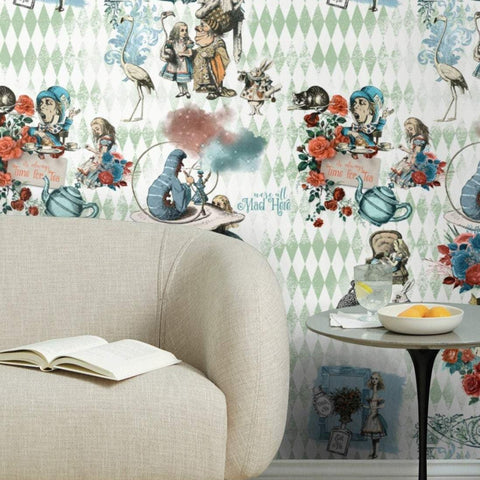
The Enchanting World of Whimsical Wallpaper
Andrea Riccardo GalieShare
Introduction
Imagine stepping into a room where the walls whisper tales of fantasy, where colors dance, and patterns play. This is the enchanting world of whimsical wallpaper—a world that defies the mundane, bringing joy, wonder, and creativity into our living spaces. Today, whimsical wallpapers are not just decorative choices; they are narrations of whimsy and charm, transforming homes into magical realms.
The Rise of Whimsical Decor
In recent years, the desire for personalized and expressive home environments has led to the resurgence of whimsical decor. This trend caters to those who seek to infuse their spaces with personality, narrative, and a touch of the fantastical. Whimsical wallpaper, in particular, has become a favorite tool for designers and homeowners alike, offering an immediate transformation of spaces with its unique ability to combine artistry and playfulness.
Defining Whimsy in Wallpaper
Whimsical wallpaper is characterized by its capacity to enchant and engage. Whether through captivating fairy-tale landscapes, cheeky animals in unexpected attire, or fantastical geometries, whimsy is defined by surprise, delight, and a departure from the ordinary. It invites onlookers into a visual dialogue, sparking imagination and often, a smile.
Historical Roots of Whimsical Wallpaper
From Victorian Fancies to Modern Marvels
The roots of whimsical wallpaper trace back to the Victorian era, a time when wallpaper became a popular method for expressing one’s status and taste. Early whimsical designs often featured bucolic landscapes and were inspired by the burgeoning interest in fairy tales and exotic lands. As the printing technology evolved, so did the complexity and creativity of wallpaper designs, allowing for more intricate and imaginative scenes that captured the Victorian fascination with the natural world and the fantastical.
Influential Designers and Movements
Throughout the 20th century, several designers and movements have left their mark on whimsical wallpaper. From the bold, psychedelic patterns of the 1960s that echoed the era's spirit of freedom and experimentation, to contemporary designers like Wes Anderson, whose distinctive visual style has influenced wallpaper designs with its symmetry, color, and eccentricity. These influences have continued to evolve, blending historical motifs with modern whimsy.
Characteristics of Whimsical Wallpaper
Colorful Palettes and Playful Patterns
The hallmark of whimsical wallpaper is its vibrant use of color and pattern. Bright, saturated hues interplay with pastel tones to create visual intrigue, while patterns range from the intricate to the boldly graphic. Each design element is chosen for its ability to captivate and tell a story, creating spaces that feel alive and dynamic.
Themes and Motifs
Central to whimsical wallpaper are the themes and motifs that serve as its narrative backbone. Enchanted forests, mythical creatures, and whimsical cityscapes are just a few examples. These designs often incorporate a sense of movement and life, as if the scenes depicted are unfolding on the walls themselves.
Creating Joyful Spaces with Whimsical Wallpaper
Selecting the Perfect Room
Whimsical wallpapers can transform any room, but they particularly shine in spaces designed for creativity, relaxation, or play. Children’s bedrooms, home offices, and reading nooks become canvases for imagination, where walls can inspire and comfort.
Combining with Decor for a Cohesive Look
Pairing whimsical wallpaper with decor requires a thoughtful approach to maintain balance and harmony. Furniture and accessories in solid colors or with minimalist designs can allow the wallpaper to take center stage, while echoing a color or motif from the wallpaper in textiles or artwork can tie the room together.
Conclusion
Whimsical wallpaper invites us to embrace the joy and creativity that design can bring into our lives. It challenges us to break free from the conventional and to decorate our spaces with stories, dreams, and a dash of magic. In the enchanting world of whimsical wallpaper, every wall is an opportunity to inspire and to be inspired.
FAQs
- How do I choose the right whimsical wallpaper for my space?
- Choosing the right whimsical wallpaper involves considering the mood and function of the room, as well as existing decor. For a child's room, you might opt for playful patterns with animals or fairy tales. In a home office, a subtler approach with whimsical geometric patterns or light, airy designs can inspire creativity without overwhelming the space. Consider sample swatches to see how the wallpaper interacts with the room's lighting.
- Can whimsical wallpaper be used in small rooms?
- Absolutely! Whimsical wallpaper can transform small rooms into captivating spaces. Opt for designs with lighter backgrounds and smaller motifs to avoid making the space feel cramped. Vertical patterns or those with movement can also create the illusion of a taller or larger room.
- What are some tips for mixing whimsical wallpaper with other decor elements?
- When mixing whimsical wallpaper with other decor elements, balance is key. If the wallpaper is very bold, keep furniture and accessories more subdued. Use colors from the wallpaper in your decor to create a cohesive look. For highly patterned wallpapers, consider solid colors for larger furniture pieces, with accents that echo the whimsy of the wallpaper.
- How do I maintain and clean whimsical wallpaper?
- The maintenance of whimsical wallpaper depends on its material. Vinyl wallpapers are durable and can be wiped clean with a damp cloth. For paper wallpapers, dust regularly with a soft brush attachment on your vacuum and spot clean with a dry cloth. Always refer to the manufacturer's instructions for specific care guidelines to ensure longevity.
- Where can I find eco-friendly whimsical wallpaper designs?
- Eco-friendly whimsical wallpaper designs are increasingly available from retailers committed to sustainability. Look for wallpapers made from recycled materials or sustainably sourced paper, using non-toxic inks and adhesives. Online marketplaces specializing in eco-friendly home decor are great places to start, as well as directly inquiring with manufacturers about their sustainability practices.







